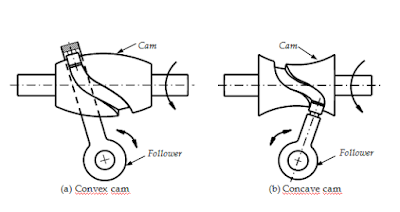Cams are classified according to the following terms :
- Shape
- Follower movement
- Manner of the constraint of the follower
According to shape :
- Wedge and flat cams
- Radial or Disc cams
- Spiral cams
- Cylindrical cams
- Conjugate cams
- Globoid cams
- Spherical cams
Now explain the above types of cams in details :
The follower F can either translate or oscillate.
In that type of cam, spring is usually, used to maintain the contact between the cam and the follower.
The cam is stationary and the follower constraint or guide G causes the relative motion of the cam and the follower.
- Radial or Disc cams :
A cam in which the follower moves radially from the centre of rotation of the cam is known as a radial cam.
Radial cams are very popular due to their simplicity and compactness.
- Spiral cams :
A spiral cam is a face cam in which a groove is cut in the form of a spiral. The spiral groove consists of teeth which mesh with a pin gear follower.
The use of such cam is limited as the cam has to reverse the direction to reset the position of the follower. It is mainly used in computers.
- Cylindrical cams :
In a cylindrical cam, a cylinder which has a circumferential contour cut in the surface rotates about its axis. For this cam follower motion can be two types :
- A groove is cut on the surface of the cam and a roller follower has a constrained oscillating motion.
- An end cam in which the end of the cylinder is the working surface.
Cylindrical cams are also known as barrel or drum cams.
- Conjugate cams :
A conjugate cam is a double-disc cam, the two discs being keyed together and are in constant touch with the two rollers of a follower.
Thus, the follower has a positive constraint.
Such cam is preferred when the requirements are low wear, low noise, better control of the follower, high speed and high dynamic loads.
A globoid cam can have two types of surfaces, convex or concave.
A circumferential contour is cut on the surface of rotation of the cam to import the motion to the follower which has an oscillatory motion.
Such types of the cam are used in limited to moderate speeds and where the angle of oscillation of the follower is large.
- Spherical cams :
In spherical cam, the follower oscillates about the axis perpendicular to the axis of rotation of the cam.
This type of cam is in the form of a spherical surface.
According to follower movement :
- Rise-Return-Rise ( R-R-R)
- Dwell-Rise-Return-Dwell ( D-R-R-D )
- Dwell-Rise-Dwell-Return-Dwell ( D-R-D-R-D )
The motion of the followers is distinguished from each other by the dwells they have.
Now the question arises in your mind is what is dwell?
A dwell is zero displacements or the absence of motion of the follower during the motion of cam.
Now explain the above types of cams in details :
- Rise-Return-Rise ( R-R-R ) :
In this type of cam, there is an alternate rise and return of the follower with no periods of dwells.
In this type of cam follower has a linear or an angular displacement.
- Dwell-Rise-Return-Dwell ( D-R-R-D ) :
In this type of cam there is rise and return of the follower after a dwell.
This type of cam are more frequently used than the R-R-R cam types.
- Dwell-Rise-Dwell-Return-Dwell ( D-R-D-R-D ) :
In this type of cam dwelling of the cam is followed by rise and return.
This type of cam is most widely used cam types.
According to manner of constraint of the follower :
- Pre-loaded Spring Cam
- Positive-drive Cam
- Gravity Cam









